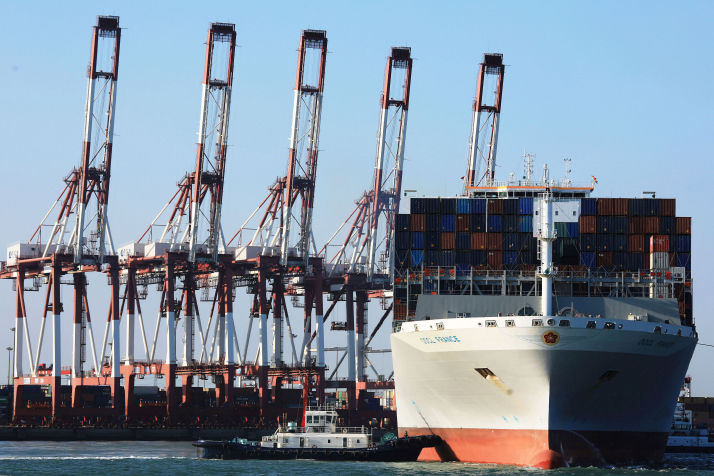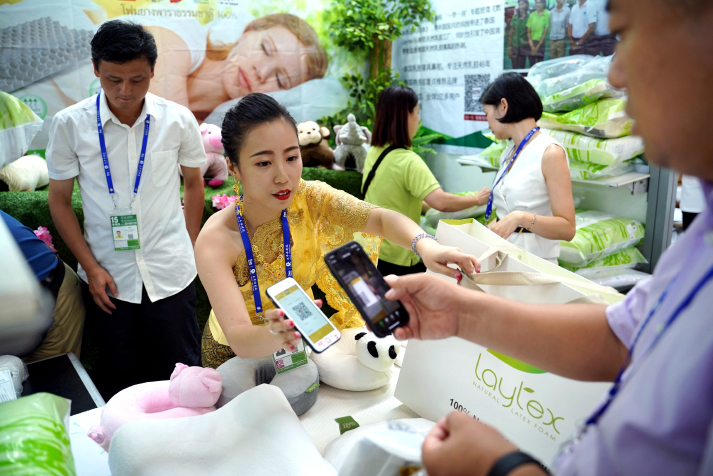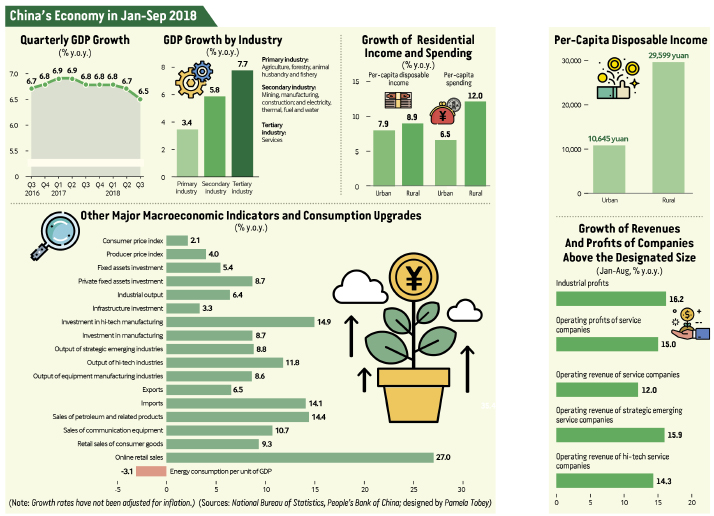| Business |
| Building Up Steam | |
| China remains on track to achieve its full-year economic growth target despite headwinds | |
|
|
 A fully loaded cargo ship leaves a container terminal at Qingdao Port, east China's Shandong Province, on October 19 (XINHUA)
Amid a complicated international landscape and domestic challenges, China's economy managed to maintain overall stable growth in the first three quarters of 2018. The stress is on resilient growth by shifting toward high-quality and sustainable development. Data released by the National Bureau of Statistics (NBS) shows that GDP grew 6.7 percent year on year in the nine months to around 65.09 trillion yuan ($9.38 trillion). But the GDP growth rate edged down from 6.7 percent year on year in the second quarter to 6.5 percent in the third quarter. A report from the financial research center at Bank of Communications attributed the slowdown to both external challenges and slowing growth in domestic infrastructure investment. According to NBS spokesperson Mao Shengyong, the trade friction between China and the United States has generated mounting instability in the global landscape, adding uncertainties to the stable performance of China's economy and bringing downward pressure. Aside from the external factors, the economy is also experiencing structural changes, which have come with both pains and gains, said Xu Hongcai, deputy chief economist at the China Center for International Economic Exchanges. "Since China is shifting its focus toward medium-to-high-speed development, the slowdown of its GDP growth this year is within expectations as the nation has entered the 'new normal' stage of economic restructuring and upgrading," He told Beijing Review. "However, stable growth of the Chinese economy can still be expected with… the domestic economic resilience strong enough to offset the external adverse effects," Mao said at a press briefing on October 19. "From the overall economic performance, we are confident that China will be able to meet the annual growth target of 6.5 percent."  A visitor buys Thailand-made latex pillows at the China-ASEAN Expo in Nanning, south China's Guangxi Zhuang Autonomous Region, on September 12 (XINHUA)
Trade resilience According to NBS data, China's foreign trade volume improved by 9.9 percent year on year to 22.28 trillion yuan ($3.21 trillion). With exports of around 11.86 trillion yuan ($1.7 trillion), up 6.5 percent year on year, and imports of around 10.43 trillion yuan ($1.5 trillion), up 14.1 percent year on year, China's trade surplus was narrowed by 28.3 percent compared to the same period of 2017, amounting to 1.44 trillion yuan ($200 billion) in the first nine months. The net exports of Chinese goods and services contributed minus 9.8 percent to domestic economic growth. "Decreasing goods trade surplus and expanding service trade deficit have narrowed China's foreign trade surplus, hence the minus contribution rate. It is a trend that may continue in the future," Xu said. Though the trade friction between China and the United States has cast a shadow on both sides and triggered concerns over an unstable market, Mao said on October 19 that it has not exerted remarkable negative influence on China's imports and exports and the overall foreign trade performance has met expectations. Imports and exports between China and its major trading partners both increased in the first three quarters. Bilateral trade between China and EU states, the United States and ASEAN nations grew by 7.3 percent, 6.5 percent and 12.6 percent, respectively. Encouragingly, the external challenges confronting China are offset by the chances brought by newly emerging markets and domestic preferential policies facilitating foreign trade. According to Mao, China saw its trade with countries along the Silk Road Economic Belt and the 21st-Century Maritime Silk Road, as well as African and Latin American countries, grow faster than its overall foreign trade in the January-September period. For example, its import and export volume with Russia, Poland and Kazakhstan increased respectively by 19.4 percent, 11.9 percent and 11.8 percent year on year. In Xu's view, the markets of many developing countries are growing rapidly, providing new opportunities and showing further development potential. China needs to expand its economic, trade and industrial capacity cooperation with those countries with newly emerging markets. To ensure the sustainable growth of foreign trade, innovative reforms are still needed. "China needs to promote industrial upgrading toward middle to high ends on the global value chain to improve its foreign trade volume," Xu said. As China strives to wean its economic growth off reliance on exports and large investment projects, the expanding middle-income group with its increasingly upgraded consumption habits has become a key pillar of economic development.  Shoppers select clothes in the Joy City Mall in Yantai, east China's Shandong Province, on October 16 (XINHUA)
Growing demands According to the NBS, domestic consumption contributed 78 percent to China's economic growth, a year-on-year increase of 14 percent in the first three quarters. The proportion of service consumption took up 52.6 percent of overall consumer spending, up 0.2 percentage points year on year. The service sector continued to stabilize the economy as a ballast stone, contributing 60.8 percent to domestic economic growth—an increase of 1.8 percentage points year on year between January and September. The growth of China's total retail sales of consumer goods reached a record low of 6.4 percent in September, mainly caused by increasing household debts due to housing purchases and the declining increase of car sales, a report by Haitong Securities, a major securities firm in China, said. However, online retail sales of physical goods boomed from January to September, despite slight slides. The growth rate was 27.7 percent compared to the corresponding period of last year. It took up 17.5 percent of total retail sales of consumer goods, a record high. To stimulate consumption growth, the authorities have launched a raft of measures. According to Xu, the development of the service sector, small and medium-sized enterprises and new technologies, as well as promoting entrepreneurship and innovation by policy, have generated new job opportunities, ensuring stable momentum of the employment market and thereby guaranteeing domestic demands. The number of newly added urban jobs across China in the first three quarters exceeded 11 million, according to NBS data. In September, the surveyed unemployment rate stood at 4.9 percent, down 0.1 percentage point both month on month and year on year. To improve people's purchasing power, the minimum threshold of personal income tax has been raised to 5,000 yuan ($720) from 3,500 yuan ($504), a recent policy to reduce the tax burden for middle- and lower-income earners. In addition, measures for special expense deductions for children's education, further education, treatment for serious diseases, as well as repaying housing loans and rents will also be rolled out. "Infrastructure investment and innovation are the two major drivers of domestic demand. China's urbanization still sees room for improvement and the manufacturing industry is not yet full-fledged. Therefore, infrastructure investment should be improved and innovation-oriented," Xu said. Restoring confidence The Asian Development Outlook 2018 Update recently released by the Asian Development Bank predicted that China's economy would register stable growth driven by supply-side structural reform and the domestic service industry gaining strong momentum. As Xu sees it, a more proactive fiscal policy will contribute to the rise of infrastructure investment in the last quarter of 2018 and the first half of 2019. Domestic consumption, another increasingly significant driving force of the economy, is also growing in a stable and resilient manner. The stock market is a barometer of the real economy. Despite the fluctuations and slowdown in the Chinese stock market in the previous months, the authorities have vowed to take measures to ensure its sound growth and boost investors'confidence. Vice Premier Liu He told the media on October 19 that several factors caused domestic stocks to fluctuate and decline: The central banks of major countries raised the interest rates, the trade friction between China and the United States, the restructuring of the Chinese economy and changing market expectations. The fluctuations and selloffs, however, generated good investment opportunities for the long-term and sound development of the stock market, Liu said. Responding to the private sector's concerns over the domestic economic slowdown and external challenges, Liu said that private enterprises have a significant role in the overall economic system and contribute much to the fiscal revenue, GDP growth, technological innovation and employment. The government will create a fairer business environment and strengthen regulations to facilitate the growth of private enterprises. On October 22, the People's Bank of China, the country's central bank, announced that it will support bond issuances by private enterprises by financing part of the initial capital. It also said that it will boost relending and rediscount quotas by 150 billion yuan ($21.6 billion) to ensure private enterprises can access loans. Xu told Beijing Review that reform and innovation have given new impetus to the economy, optimized its structure, and improved the quality of growth despite a slowdown. "The possibility that China's economy will witness a decline in its growth rate by a large margin in the future is slim. The growth rate in the fourth quarter will be over 6.5 percent. Despite a possible downtrend in 2019, a growth rate of over 6.5 percent can still be expected," Xu added.  Copyedited by Sudeshna Sarkar Comments to lixiaoyang@bjreview.com |
|
||||||||||||||||||||||||||||||
|
